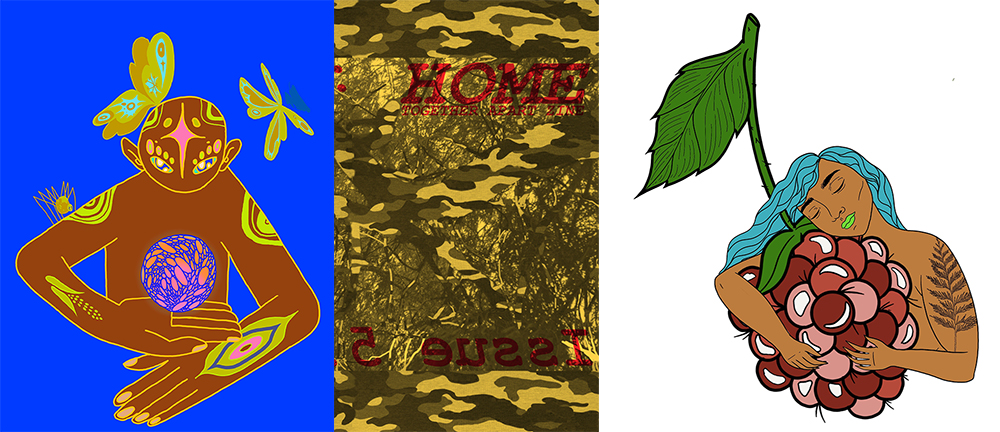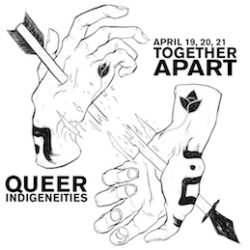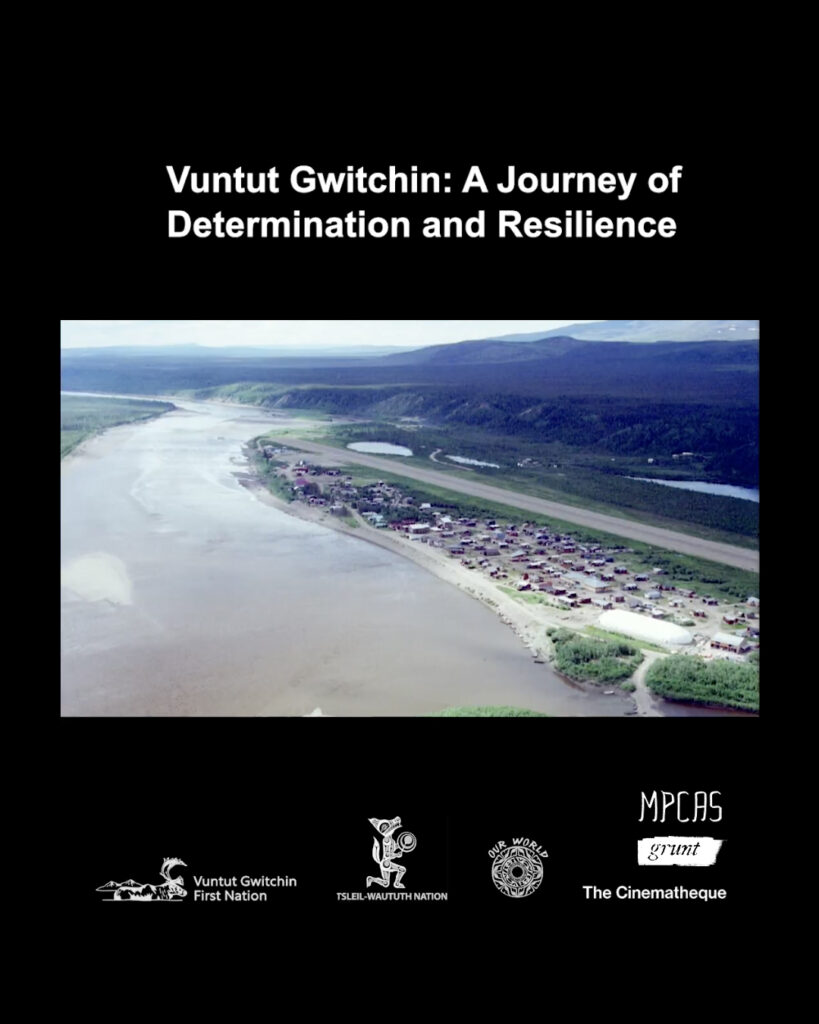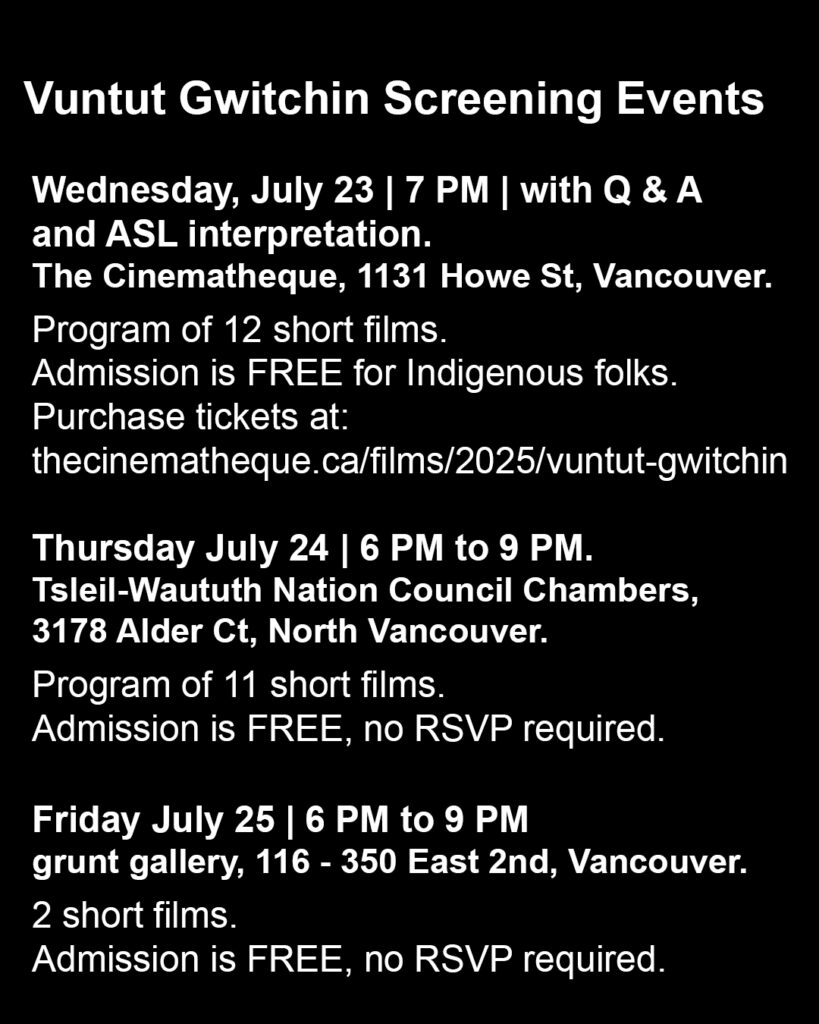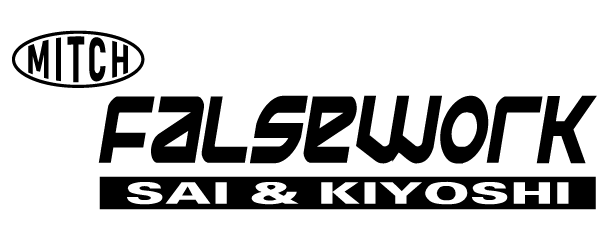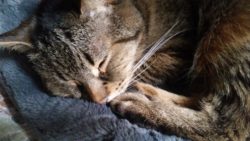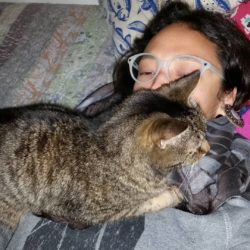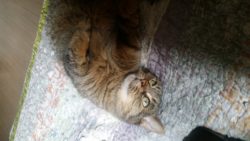Creative Access Audio Tour
[ Kay: ] Welcome to grunt gallery’s creative access audio tour of Falsework, the exhibition project by artists, Simon Grefiel and kiyoshi, curated by Mitch Kenworthy. My name is Kay Slater. I am a white, hard-of-hearing, queer settler on these stolen and unceded Coast Salish lands. As the accessibility and exhibitions manager and preparator here at grunt, I assisted in installing this work. We welcome your feedback as we develop more creative access tools for our gallery and exhibitions.
This tour has four chapters. Chapter 4 is in 6 parts related to the different exhibits in gallery. At the start of each chapter, you will hear this sound of a page turning:
( Page flips )
First is this intro. In Chapter One, I will detail entering the space and orienting yourself in the gallery. In Chapter Two, I’ll describe our welcome station and the objects available for you to use and touch. Chapter Three covers our facilities, washrooms, and C-Care stations. If you’re ready to tour the show, skip to Chapter Four, where the exhibition tour was written and narrated by curator Mitch Kenworthy. He will begin by reading the wall didactic and will walk you through the show. If you are skipping ahead, be aware that the welcome station has 2 tactile maps marked to help you navigate this tour. When Mitch moves to a new artwork, you will hear this sound of a handheld drill:
( Hand drill whirrrrrs )
Each artwork description within Chapter Four is divided into its own audio part so you can skip or return to an artwork description as you move through the show at your own pace.
Let’s get started with Chapter One.
( Page flips )
Creative Access Audio Tour – Chapter One
When approaching grunt gallery at 350 East Second Avenue from the accessible drop-off on Great Northern Way, follow the sidewalk to the building’s main entrance. Turn left at the entrance, and you’ll find us at the first exterior door, unit 116. A low-grade ramp leads to our front double doors, with automatic door buttons at waist and ankle level on a post to the right. Be cautious of the small lip at the threshold, a potential tripping hazard. Excluding Thursdays, masks are now optional and only recommended indoors at grunt; if you forgot yours, we have extras near the entrance and will not enforce their use outside of Thursdays for low-sensory and voice-off visiting hours.
Welcome to grunt gallery! We are situated on the occupied, stolen, and ancestral territory of the Hul’qumi’num and Sḵwx̱wú7mesh speaking peoples, specifically the land of the X’wmuthqueyem, Sḵwx̱wú7mesh, and Selilwitulh peoples and families. We are grateful to be here.
The current show has two installations built up from the ground and jutting from the wall. There a wide space to walk through the centre of the gallery, and all work is cane detectable and touchable. If you require assistance and are not greeted by staff upon entry, please call for help. Staff are in the office and will assist you as soon as possible. We are always happy to walk the show with you.
The public gallery space is a white cube with 20-foot walls on three sides and a 12-foot south wall that opens at the top for 8 feet before reaching the ceiling, providing light to the loft office space beyond. The office is not visible from the gallery, except for a large convex mirror that allows staff to see visitors. A tone rings when people enter the space.
On low-sensory and voice-off Thursdays, a staff member will be available but will not greet you, allowing you to move at your own pace. If you are non-visual, low-vision or Blind, call out for help anytime. If you are sighted, please silently approach a staff member. Staff will respond either through text-to-speech or will speak softly to assist you to preserve the quiet atmosphere and low-sensory programming. We have hard-of-hearing staff on site, so a visual wave may be required to get their attention.
( Page flips )
Creative Access Audio Tour – Chapter Two
As you enter the gallery, immediately to the right on the west wall is a sanitization and welcome station. The station is white with black labels in English, high-contrast icons, and some braille labels. There are three open shelves, including the top surface and two pull-out shelves below, and two closed drawers with d-hook handles.
On top of the welcome station is our gallery spider plant, Comos, who is watered on Wednesdays by our volunteer attendant Jinnie Saran. The top surface holds a leather-bound guestbook with a black pen, a bottle of hand sanitizer, and a box of masks with tongs. A digital tablet allows you to browse the exhibition page on our grunt.ca website or access our Big Cartel eCommerce store. The voice-over is turned off on the iPad, but can be turned on upon request.
On the first pull-out shelf, on the left, is the exhibition binder with large print information about the space, the show, the artist, a transcript of this tour, and the exhibition map. On the right are a series of tactile objects. Our tactile objects are creative access tools designed to create a point of entry for non-visual, Blind, or partially sighted guests who may wish to experience the work through touch or by bringing the objects close. However, tactile objects are also sensory objects that can be used by sighted folks who wish to feel a connection to the work and those who enjoy or are supported by having objects in their hands to touch.
These tactile objects are provided as a sensory point of entry into the works and are not necessarily representative of the work or equivalent to experiencing the works through explorative touch. This show in particular can be touched, but some of the wood is raw and unfinished, so please take care in exploring to avoid splinters. The tactile objects here can be carried and explored liberally. We do not present these objects assuming that you have never had access to a charred and carved piece of wood, but we are also not assuming that you have had these experiences. Smell them, hold them, observe them. Use them however you’d like as you engage with the show.
On the second pull-out shelf, to the left, are laminated maps of the space. Also within these shelves are two tactile maps.
A tactile dollhouse map of the gallery, and a flat 2D tactile map of the spaces past the gallery box. Use the dollhouse and 2D tactile maps to follow along with chapter 4 of this creative access tour while in gallery. Works are indicated by small-scale versions of the installations in the dollhouse map with braille markers A through H.
On the laminated map, all the installations are named by the artists. It is worth noting that kiyoshi writes his name all in lower case without a last name, and his works are also listed all in lower case.
To the right of the maps are two Yoto audio players with large, friendly buttons. These players contain this tour and audio of any text within the binder. There is also a scannable, laminated QR code that links to this audio tour. On Thursdays, the Yoto players are moved to their carrying cases for use with headphones.
Below these are the two closed drawers. The first contains carrying cases with straps for headphones and the Yoto audio devices, allowing hands-free use. There are also tactile stim objects made by local artist Veto Monteiro.
The lowest drawer contains earmuffs for large and small bodies, specifically for those with noise sensitivities.
That concludes the description and tour of the welcome station. In the next chapter, I will tell you about our washrooms and care stations. If you’d prefer to continue with the exhibition tour, skip to Chapter Four.
( Page flips )
Creative Access Audio Tour – Chapter Three
If you need to use the washroom, it’s at the far end of our space. Exit the gallery through the doorway and continue following the west wall (to your right when you entered). Pass by the media lab, and when you reach the back wall, take a left and walk through the small kitchenette to our single-room, gender-neutral washroom.
If you’re using the 2D tactile map, the washrooms are located at H.
An automated door button to the right holds the washroom door open for 14 seconds. You can also push it open if it’s unoccupied. Inside, to the right of where you entered, is the lock button which creates a visual indicator that the washroom is in use. To exit, you can open the door manually or hover your hand over a button above the sink, below the mirror.
Near the exit button is a vertical cubby stack of supplies. Please help yourself to items like hair ties, disposable floss, sanitary napkins, and condoms. This is part of our C-Care program, Community Care for Artist-Run Events.
Speaking of C-Care, we have a tea station in our media lab at location F. If you need some energy, you can help yourself to a drink or a puréed fruit snack. This offering may occasionally be put away during low sensory hours, but you can always ask our team for a drink or snack.
In the media lab, a long table is placed perpendicular to the entrance (on your left as you approach from the gallery) with a variety of chairs closest to the gallery, and a handmade bench on the far side. The space is also decorated with objects, zines and posters shared by collaborators to the artists and curators. This space has been designed as a public gathering and hang out space during the run of the show. Have a seat, have a tea, and check out the various objects. These have been listed and described in the show binder and digital description site. Feel free to hang out, chat, draw and take a break here.
If you’re using the 2D tactile map, the C-Care tea station and break room is at location G marked by 3 rectangles.
We now arrive at Chapter Four, where Mitch will start his exhibition tour next to the welcome station at location A, as if we had just entered the gallery and stepped right to sanitize our hands and grab a map.
( Page flips )
Creative Access Audio Tour – Chapter Four
Part one: show introduction and didactic
[ Mitch Kenworthy: ] Hello, my name is Mitch, and I am the curator of this exhibition. I wrote and narrated this script and will take you on a tour of what I see in the gallery.
I am starting this tour at the welcome station, Location A on the tactile maps in the gallery. Above the welcome station, there is a black vinyl exhibition logo installed on the gallery wall. This vinyl was designed by Simon in reference to the logo of a trades or construction company. The stylized font that Simon used in this design is derived from the font used on Tyvek rainscreen material, a moisture barrier often visible on the sides of buildings under construction. The vinyl reads: “Falsework,” underneath which it reads “Sai & kiyoshi”, with a horizontal oval containing the text “Mitch” located at the top left above the “F” in “Falsework.” I will note that Simon goes by both Simon and Sai, and opted to use Sai for his name on this. Beneath the stylized logo, the vinyl reads in plain text “curated by Mitch Kenworthy, May 1 to June 14, 2025.” This same vinyl, but in white, is also installed on the glass of the front doors of grunt gallery and is viewable from the exterior.
From the welcome station, I am going to walk into the centre of the gallery space and turn to my right so that I am facing the west wall of grunt gallery.
( Hand drill whirrrrrs )
Part two: past future past
I am now looking at Location B on the tactile maps. Titled past future past, this piece is a large wooden structure built by kiyoshi that stands against the gallery wall. It is constructed out of two-by-fours and plywood. It is approximately nine feet tall, eight feet across, with a depth of about four feet. The structure can be touched and is cane detectable.
There are four large casters installed on the base of this structure. They are a bright, juicy red colour which pops out and adds a stylish flair to the piece. The casters are locked, but if we were to unlock them, the structure could be rolled throughout the space by pushing it. For safety, there is also a carabiner attaching the structure to a metal hook on the wall. A carabiner is a metal hook with a latch that can be easily fastened and unfastened. It is used to link objects together.
kiyoshi made this piece in reference to a scaffold platform that workers on a jobsite use to climb on top of in order to work at heights not accessible from the ground. This piece is sturdy, and can be used as such; kiyoshi and myself climbed on top of it in order to install some artwork over the top windows of grunt gallery that I will describe later on in this tour. To get on top of it, kiyoshi and I used a ladder. There is no ladder in the exhibition space right now.
Some of the two-by-fours that kiyoshi used to construct this piece are plain bare wood, but other two-by-fours have squiggly, blackened patterns burned onto them. kiyoshi made these patterns by pouring grains of rice onto the wood that marked out the patterns, and then used a propane torch to burn the wood. The areas that had rice on them were protected from the torch’s flame and thus did not burn and blacken. On top of the structure are horizontally placed panels of plywood that make up the floor of the platform.
Installed on the underside of the platform is a fluorescent light, the bulb of which has been taped with transparent red Tuck Tape branded tape, so that it casts a warm, reddish glow onto the space beneath. kiyoshi loves using Tuck Tape and it is a material that makes its way into many of his artworks.
Tuck Tape is commonly used in construction as a strongly adhesive and water resistant tape, and it was through working various construction jobs that kiyoshi developed his affinity for it. kiyoshi and I shared a studio together and are also roommates. In the context of sharing these different spaces, I have seen him use Tuck Tape to decorate all sorts of surfaces and apply Tuck Tape over various light fixtures and lightbulbs to create a warm and ambient glow. As you will come to realize, Tuck Tape is present throughout this exhibition, and there are a few places where it can be touched.
Underneath the scaffold structure are two white plastic deck chairs that face outwards, towards where I am standing. The “roof-like” top of the structure is 8 feet tall, so you don’t need to worry about bumping your head if you walk underneath it. If you like, you may sit on one of these plastic chairs. The backs are a little bit bendy, but they are stable. They might have been the cheapest plastic chairs that we could purchase at Canadian Tire. kiyoshi wanted to reference the cheap and provisional seating that he is accustomed to finding on the various construction sites that he has worked on, which workers use to sit down and take a coffee break, smoke a cigarette, or have their lunch.
Mounted onto the back of this structure is a square piece of plywood set in a frame of two-by-fours. The plywood looks weathered and worn. Its surface is intensely patterned with burned and blackened lines that follow and accentuate the wood’s natural grain. kiyoshi used a propane blow torch to make the burns, and a belt sander and skill saw to carve reductive marks and gestures into the plywood. In some places, the marks go so deep that they breach the plywood, creating wound-like holes.
A belt sander is one of Kiyoshi’s most used tools. It is an electric hand tool used to sand and smooth the surfaces of wood and lumber. A belt sander has two handles on the top and a continuous loop of sandpaper on the bottom that, when powered on, rotates very fast and with significant force. It is thus an efficient way to sand down a large or rough surface. kiyoshi does not use a belt sander in a traditional way, but works intuitively with it to create interesting and unexpected marks and gestures, kind of like he is drawing or sculpting the wood with it. On this plywood, some of the marks are thinner lines, and some are broader gestures. kiyoshi achieved these different marks by employing a variety of different motions with the belt sander, as well as cutting it with a skill saw.
While this plywood looks rough and weathered, the belt sander has created a surface that is surprisingly smooth and pleasurable to touch. You can run your hand over the surface and feel the various grooves and marks in the wood. kiyoshi has always encouraged people to engage haptically with his work, appreciating through touch the different surfaces that he creates. Even though this surface is smooth, the areas where the belt sander has made holes in the wood could still be a little bit sharp and you want to be cautious of splinters.
I am going to walk forward so that I am underneath the structure, and sit down in one of the plastic chairs.
( Hand drill whirrrrrs )
Now, I am comfortably seated on one of the chairs. Above my head, like a ceiling, is the underside of the sheets of plywood that make up the platform on which someone on top of this structure would stand. The surface of the plywood is very lightly blackened with burned marks and gestures. Inset in the plywood, directly over my head, is the square fluorescent light panel that kiyoshi customized with red Tuck Tape. There are many criss-crossed layers of tape and they have some punctured slits and cuts. Straight ahead to the east wall of grunt gallery is a plywood wall built by kiyoshi that supports an installation of videos by Simon playing on three monitors. To my left are the front windows and entrance of grunt gallery. The windows have an installation of Tuck Tape on them.
I am going to get up from this chair now, walk forward and then turn to the left so that I am facing north.
( Hand drill whirrrrrs )
Part three: notes
I am now in front of Location C on the tactile map. This piece is also by kiyoshi. It is titled notes. It is an installation of Tuck Tape on the right hand side of the gridded north facing front windows of grunt gallery, as well as the central top window. The Tuck Tape has been applied on every second window pane to create an alternating checker-like pattern.
The Tuck Tape on each window pane has been applied the same way. It makes a rectangle pattern that encompasses the entire width and length of the window pane. The pattern is made out of strips of Tuck Tape applied starting from the top right corner that follow the edge of the window in a counterclockwise direction, filling in the space with concentric rectangles that diminish in size. In the very centre, a thin, single strip is left un-taped. This makes a narrow rectangular slit that I can still see the exterior through.
The top window panes on this grid of windows are quite high, and kiyoshi specifically designed the aforementioned scaffold structure so that he could reach these top windows and install the Tuck Tape onto them. kiyoshi and I wheeled the scaffold platform to the windows and used a ladder to climb onto it. From there, he cut strips of Tuck Tape the appropriate length and handed them to me. I then applied them. When we finished, we wheeled the structure back to its position against the west wall.
You can gently touch the Tape Tape and feel the subtle texture made by the overlapping layers. Looking through the Tuck Taped portion of the windows, I can still make out vague shapes of foliage and see the road with cars driving past the gallery, but everything is slightly hazy and is tinted red.
kiyoshi enjoys working in situ and responding to conditions like space and light. While he knew that he wanted to do something over the windows of grunt gallery, the exact form of notes was developed over the course of the installation. In helping kiyoshi install this piece, I gained a similar appreciation for Tuck Tape as he has. It is easy to stick onto the windows, and easy to tear or cut. It can also be peeled off the windows without too much difficulty. It is a very practical material, and I now understand why kiyoshi always has a roll of Tuck Tape around.
I am now going to turn my body to the right. Installed on the east wall of grunt gallery is a plywood wall built by kiyoshi titled I love you as a thought, with three monitors mounted onto it playing videos by Simon. This is Location D on the tactile map, but I haven’t moved yet from the windows. Let me describe what I see still standing near the windows.
The wall is made out of three eight foot high by four foot wide plywood panels that are screwed into a two-by-four frame. This frame holds the plywood panels off of the gallery wall by about a foot and a half. From my current position, I am looking at the north facing side of the piece, and I can see the gap between the plywood and the wall, where kiyoshi has installed three speakers on stands. I also see the power and audio cables that are running from the monitors through the plywood. This peak into the behind the scenes of how the work is powered and where the sound plays from is something I appreciate, allowing an insight into the process and care that kiyoshi put into installing this work.
I am going to walk into the centre of the gallery space and turn to face the east wall, so that I am looking directly at this plywood wall, Location D on the tactile map.
( Hand drill whirrrrrs )
Part four: i love you as a thought
I am now standing in front of Location D on the tactile map. For now, I will ignore the monitors playing Simon’s videos, and focus on describing the plywood wall onto which they are mounted. The three eight foot tall by four foot wide panels are standard dimensions of plywood; kiyoshi has not cut them down, but instead based this wall on these dimensions. kiyoshi has again used a belt sander to make marks and gestures into the plywood. Plywood is made out of multiple very thin layers of wood veneer that have been glued and compressed together, and kiyoshi’s belt sanded marks reveal these layers, allowing me to see and feel their slight variation in colour and texture. The three panels look like they were all belt sanded together. Gestures on the left most panel move into the centre panel and can be traced all the way to the far right panel.
The gestures are large and sweeping. While abstract in nature, the shapes and lines have an organic quality to them. I think about the marks left in wood by a termite, or the roots and branches of a tree. The gestures on the central panel are the most dense. The bottom right quadrant of this central panel has an especially worked area. Where the marks on most of the panels look like they were made by a smooth and rocking motion with the belt sander, the bottom right area looks to be worked in a staccato-like swooping and sculpting motion. The plywood is still smooth to the touch, but notably rougher than the previously described plywood that is mounted onto the piece past future past. Particularly rough is the bottom right area of the central plywood panel. You are again free to touch, but do so lightly and be wary of splinters.
I will now describe the video installation that plays on the three monitors mounted onto the plywood wall. The piece is titled Ceremony for Smoke and Mirrors and is Location E on the tactile map. These videos are a three channel installation and are meant to be viewed all at the same time. I find myself spending some time with a scene from one video, then moving my gaze to another, then observing what is happening on all three at the same time. Each video is about a ten minute loop and is composed of multiple short, static shots. The shots fade from one shot to another, and at points one shot is even overlaid on top another shot.
Much of footage in these videos was shot by Simon on the docks of North Vancouver, where for several years he was employed on a predominantly Filipino crew doing maintenance and fabrication on luxury yachts. Simon would shoot videos of himself and his co-workers going about their daily work and tasks. The footage included here consists of scenes of painting, constructing furniture, doing deck maintenance, cleaning, and other scenes of work. Due to an issue with permanent residency paperwork, Simon was unable to return from a recent trip to SouthEast Asia, and he completed the edit of these videos from his sister’s home in the Philippines. Included in the videos is footage from his time on this trip. Scenes of working on yachts in North Vancouver fade into scenes from the Philippines, such as a military parade or a shot of Simon’s relative taking him out fishing on a traditional wood boat and showing him how to bait a hook. These shots are also interspersed with footage downloaded from TikTok that show Filipino workers on freighters and cargo ships dancing to Budots (b-u-d-o-t-s) music, as well as Simon taking selfie videos of himself dancing in his room.
Budots is a specific form of electronic music and dance that originated in working class areas of the southern Philippines, and in recent years has become popular across the Philippines. The music is fun, and the dance involves bending one’s knees, slowly gyrating at the hips, and moving one’s hands in tight circular motions above the head.
The sounds in each video play over top of one another. It was Simon’s intention to reference the din and noise of a worksite, where the sounds of tools, music, banter and conversation all overlap.
I have now described all of the works in the main exhibition space. From here, I am going to orient myself to the south and begin walking to the back of grunt gallery. On the west wall, to the left of past future past, there is more vinyl on the wall. This vinyl has the same logo and font as the other vinyl, with added text below that reads “Break Room, Exhibition Continues” with an arrow directing me to continue to the back room of grunt gallery. I walk past the stairs on my left hand side that lead to the upstairs offices and I am now in the Break Room.
( Hand drill whirrrrrs )
Part five: break room
The Break Room is Location G on the tactile map. The Break Room consists of a long white table along with rolling chairs and a bench for sitting. The rolling chairs can be pushed aside so that a wheelchair can be pulled up to the table. Installed in this space is a collection of artworks and texts by people who make up the community that kiyoshi, Simon, and myself call our friends, family, co-workers, and collaborators. Some of this material is placed on the table that is in the centre of the room, other pieces are installed and hung on the walls around it. This is a casual space, with a casual display of artworks. Myself and the artists want people to feel comfortable to take a seat here, appreciate the collection of materials available, or just hang out and enjoy a conversation. The grunt team also invites you to pour a cup of tea.
With that being said, I encourage you to take a seat. I am going to sit down on the south side of the table, on a bench that kiyoshi built out of wood. This bench should also be touched, as it has a delightfully smooth, bevelled edge to it.
I will now provide a brief overview of The Break Room. For full visual descriptions of the artworks on display, you may consult the exhibition binder. Looking at artworks in this room is a bit like a treasure hunt; they are informally displayed throughout the space, and invite conversation and questions about who made it, what it is, why it might have been included. At the end of the day, the relaxed atmosphere of the space as a whole is more important than the individual works.
The Break Room was conceived by the artists as an ode to a jobsite break room, where workers eat their lunch, enjoy a moment of quietude, or hang out with their co-workers away from the boss’s gaze. Over the course of producing this exhibition, Simon spoke a lot about the break room at his job on the docks of North Vancouver. Simon’s break room had a pool table in it. He and his fellow co-workers enjoyed games during lunch or after the work day. For a brief moment, he hoped he could bring a pool table into this break room. For multiple reasons, that was not feasible. Simon also spoke about the dynamics that took place in his break room. It was a space where he and his co-workers could freely complain about the bosses and the wealthy owners of the yachts they worked on. It was also a place they shared food, enjoying communal lunches in a manner that the few white co-workers on his jobsite were unaccustomed to. In a reading that Simon presented several years ago on his yacht work experiences, I recall Simon noting a particular white coworker who was new on the job. He would bring his lunch and eat it alone out of his tupperware, while eyeing the food that the Filipinos brought to share with one another. After a few weeks on the job, this person also began bringing food to share with the others, taking part in the pleasure and camaraderie of a communal lunch. This past August, myself and the artists met to go over some particulars of this exhibition. Simon brought up the idea of a break room being part of this show. kiyoshi and I readily agreed.
On the table of the Break Room is a collection of zines, some ceramic pieces, a flan tin with candles. At the west end of the table is a coil bound sketchbook and black ink pen. Guests are invited to write, doodle, or draw in the sketchbook. Beside the sketchbook is a saddle stitch stapler. This stapler was used by Kay Slater to bind kiyoshi’s zine. kiyoshi was curious how the saddle stitch stapler worked, and when Kay brought it out, kyioshi requested that it be included with the breakroom material, so that if people wanted to, they could staple together their own zines.
On the east end of the table there is a small 22” TV monitor that plays a video by kiyoshi. This is Location F on the tactile map. The TV stands on a homemade mount that kiyoshi made out of two-by-fours and Tuck Tape. The tension of the Tuck Tape is what keeps the monitor upright, so be very gentle if you wish to touch it.
The TV plays a video piece by kiyoshi titled 7-9-1 body break. 7-9-1 body break is composed of a looped series of shots taken out the window of a car while driving. All of the shots are a pinkish hue that kiyoshi achieved by taping a piece of Tuck Tape over the lens of the iPhone used to shoot this footage, effectively making a filter out of the Tuck Tape. The video has an ambient, background-like quality to it. It is like having a TV on that you are not fully paying attention to.
On the walls are some photographs Tuck Taped up in the temporary fashion of posters, a few drawings, and a poster that reads: “Fuck your job, money is fake, society isn’t natural, and the sun is going to explode.” There is also a trucker’s cap with the Tuck Tape logo, and another poster with a clock that shows it is beer o’clock. In a provisional and in-progress manner, an unsecured diagonal corner shelf made from pieces of two-by-fours supports a lamp made out of a vacuum filter.
Along the south wall, there is a piece of plywood that has a black and white print placed onto it, and a plinth on the ground, on top of which are several sculptures made from different materials, like cement, left over sticker paper, and kitchen strainers. The collection is eclectic, fun, and showcases the breadth of the community in which myself and the artists’ practices are situated and supported. Check out the binder for more details on each of these objects, and keep checking back, as the artists plan to add more objects throughout the course of this exhibition.
That concludes the tour.
( Hand drill whirrrrrs )
Part six: conclusion
[ Kay: ] With that, we conclude the described tour of Falsework. Later, during the exhibition’s run, we will have a publication available for the show and an alternative text version available in plain text or AI-generated audio, both on our website and through the Yoto players in gallery.
Thank you so much for joining us on this creative access audio tour! We’d love to hear your thoughts on this experience and how we can improve it. If you carried any tactile object(s) during the tour, please return it to the welcome station! We acknowledge that we cannot be everything to everyone, and respect that our creative access explorations may not serve your needs. You can reach us at access@grunt.ca or chat with any of the staff on site with any feedback you have the capacity to provide.
Thank you again.
Curatorial Essay
Falsework: Simon Grefiel & kiyoshi
by Mitch Kenworthy
Out of another rebar latticed pit emerges another homogenous glass and concrete building. I pass multiple construction sites on my way to work each day. I appreciate the daily progress of a thing being built; the itinerant liminality of a scaffold exoskeleton, the slender verticality of falsework columns supporting freshly poured layers of concrete slab, the bright white rectangle of a piece of Tyvek billowing in the wind like a sail. I prefer the under construction to the constructed. I prefer the means to the ends. Better to write about the working, and the way the work is done.
“I LOVE baseball!” So goes the refrain in a text kiyoshi wrote and presented as a public reading a few years ago. I can attest, as kiyoshi’s friend, roommate, and former studiomate, that he does indeed love baseball. Watching baseball, playing baseball, “the most pastoral sport,” kiyoshi declares. Over the years, he has filled me in on the finer points of the game, from oddball pitching techniques and bullpen tactics, to the proletarian ethos of careers spent bouncing around the minor leagues. Sitting in the dugout, kicking at grass in the outfield, the pleasure of swinging a real wood bat; located in kiyoshi’s love of baseball is an appreciation for rhythmic slowness and haptic beauty that maps aptly onto his expansive and embodied practice.
I knew kiyoshi at first primarily as a performance-based artist. His pieces somatically engaged space and architecture in a manner plainly legible in his material work, where a performative spirit lingers in the emphasis that he puts on the act of doing and making. kiyoshi privileges process and is attuned to the attendant sensations and pleasures of working on things. He works slowly, whittling away in the studio, working on other things; gardening, fashioning furniture for his bedroom out of appropriated lumber, redesigning the interior of our apartment. These activities are all significant to his practice, a practice in which he not only responds to the conditions that he is situated in at a given time, but actively constructs them.
kiyoshi is keenly sensitive to the spaces he inhabits. In the studio that we shared, he walled in his section with two-by-fours and plywood. I was struck by the fact that he didn’t make this space and then make work within it. Rather, the space was his work. During this period, kiyoshi spent most of his spare time at the studio—even surreptitiously living there—and his space reflected his needs and desires at a given point; closing in, opening up, summarily deconstructed, reconfigured, and rebuilt in what was a years-long pursuit of architecting a space. The back doors of this studio opened up into a well traversed alleyway in Vancouver’s Riley Park neighbourhood. kiyoshi preferred them ajar, using the exterior to do his messier woodwork (notably burning and belt sanding lumber that made up the walls of his space). I appreciated the generosity with which he engaged passersby, conversing with them about what he was up to, establishing relationships with regulars. This way of working was out of necessity, keeping sawdust and fumes away from his studiomates. But there was also a clear affinity for the social and public context.
In the tools and materials that kiyoshi uses, necessity and affinity meet again. There is an economic frugality at play. He has the tools he uses because of the jobs that he works. Materials like lumber are often collected in the form of leftovers and offcuts and are then reused in multiple projects, becoming wrought indexes of his labour in the process. But there is also a familiar affection for these tools and materials, one born out of long hours working with them in various trades and construction jobs. Formative to kiyoshi are the years he spent working for his father’s contracting company doing renovations around Vancouver. Days spent in rooms and buildings in various stages of construction and demolition are alluded to in the bare and unfinished stance of his woodworked structures.
In Falsework, kiyoshi shows a plywood wall and scaffold-like platform, respectively titled past future past and i love you as a thought. These works importantly also do work; the plywood wall supporting a series of monitors playing videos by Simon, and the scaffold-like platform functioning as a stage for a performance and a means to install notes, the Tuck Tape installation across the top windows of grunt gallery. Much of the lumber that kiyoshi used to construct these pieces formed the walls of his current studio space. Dismantled, brought to grunt gallery and constructed in situ, the works and the site of their production are effectively collapsed.
Last summer, I attended a beer-league baseball game that kiyoshi was playing in. He wore a Ford branded trucker cap that he had tie-dyed with bleach in our bathtub, reflective red cycling sunglasses purchased on his way to a landscaping gig, and a pair of electric blue cleats with knee high socks. His stance at bat had the same singular flair as his outfit; acutely crouched while dramatically shifting his weight from foot to foot. Between innings, kiyoshi offered me a beer pulled out of a waxed cardboard produce box that he had fashioned into a front rack for his bicycle and adorned with Tuck Tape. Everything kiyoshi does is approached with a certain aesthetic flourish, an appreciation for the potentials of ruggedly utilitarian matter, and an ethos of care. I think about a quote by Jan Verwoert that kiyoshi shared with me in an epistolary exchange of writing from one of our previous projects, “and why do we often enough go to extremes to do the things we seek to do in the way we think they need to be done? Because we care.”
My first engagement with Simon’s practice was caring for his plants. Potted in vessels made out of delicately sautered stained glass, they were shown in Flying Kiss for Receiving Cheek, an exhibition in the window space of The Libby Leshgold Gallery, where I work. It was 2021 and we were in the midst of COVID-19 lockdowns and restrictions. Access to the gallery was limited and discouraged. The windowed exhibition space heated up like a greenhouse in the sun, and Simon’s plants withered without daily watering. A banana tree was particularly mal-affected. During this unstable and uncertain time, my days took on a rhythm based on biking down to the gallery every afternoon to ensure these plants were properly watered and cared for. To my great pleasure, by the close of the exhibition the banana tree was thriving and had even begun to sprout new fronds.
Following this exhibition, the plants and stained glass vessels were shipped to the Vancouver Art Gallery, where they were included in that year’s Vancouver Special triennial. Concern over fluctuating relative humidity levels meant that staff at the VAG were stingy with watering, reportedly telling Simon it could impact their ability to one day borrow a Rembrandt. When I attended the exhibition, the banana tree was in a sadly withered state. It presented a very different read than one fecund and verdant; a victim of colonial museology, whose care ironically came second to borrowing a work by a painter ensconced in a Dutch Golden Age contingent on VOC exploitation of Austronesia.
Last year, I visited Simon’s studio. Neatly organized in one of his workbench drawers were the pieces of stained glass from the vessels in which the banana tree and other plants were shown. He had taken them apart and was refashioning them into new work. The glass was stored along with the rest of his vast collection of materials: pieces of teak, tubes of silicone and marine caulking, dried plants, memorabilia from the Philippines, offcuts of wood and myriad other items. Like kiyoshi, Simon reworks the same materials into multiple pieces and projects, and readily gleans these materials from his various day jobs. The stained glass were offcuts collected while Simon worked as a studio assistant for artist Julian Hou. Other materials were collected as leftovers from his job at the docks in North Vancouver, where Simon was employed on a predominantly Filipino crew doing maintenance and fabrication on high end yachts. It was here that he shot much of the footage for his three channel video installation, Ceremony for Smoke and Mirrors.
Expanding on his propensity to collect and gather material, the videos in this installation are composed from a vast archive of digital material shot and saved on Simon’s phone. They are edited in a way that, to quote the artist, maintains “a social media vernacular.” Simon is active on social media. His instagram stories, which I understand as an extension of his practice and desire to create and communicate, showcase insights into the places and communities in which he is situated at a given time, time lapses of a day’s work, research into interconnected Austronesian pasts and presents, notes on the politico-ethno-linguistic significance of Filipino budots music, and scenes of raves and dance parties that for Simon are of course a form of research, too. They provide a well framed glimpse into whatever has piqued Simon’s nimble curiosity at a given time. Follow him to see what I mean: @sa4iiii.
Shooting footage at his jobsite affects a reformatting of Simon’s wage labour into an extension of his artistic labour. It is a creative act, that along with dancing, day dreams, longings for home, and the fellowship and camaraderie of coworkers, is presented in Ceremony for Smoke and Mirrors as inevitably infiltrating and ornamenting the rote work of manual labour. For Simon, a Waray-Waray speaking Filipino working on yachts in North Vancouver, this piece is also a tender reflection on his connection to a long lineage of Filipino marine labourers; from Enrique of Malacca, to Ben Flores, to the local fishermen in Simon’s hometown of Tacloban City, to his coworkers on the docks of North Vancouver and the Filipinos employed on international freighters and cargo ships the world over, working in an industry where hierarchies are well stratified based on what author Leila Kahlili locates as “the global colour line running through wage and recruitment strategies.” Captains and officers regularly consist of white Europeans, while under their purview are crews most often made up of workers from the Global South. We all work for money, but some money is worth more than other money, some work pays more than other work, some bodies do work that other bodies do not. But see Simon’s videos: Who are the ones dancing budots on the decks of freighters as they traverse the world’s seas? While not an antidote to global economic disparities, it is an act that asserts—along with any creative gesture not in the service of producing surplus value for one’s employer while on the job—that the working body is still the worker’s body.
When we conceived of this exhibition, Simon’s plan was to solely use footage shot at his North Vancouver jobsite. Due to an issue with permanent residency paperwork that has left him unable to return from a recent trip to SouthEast Asia, he finalized this piece from his sister’s home in the Philippines. Ever responsive to his site and circumstance, the final edit includes footage collected from his time on this trip, condensing and overlaying the vast expanse of the Pacific Ocean that both separates and connects Tacloban City in the Philippines with the Salish Sea that laps against the docks of North Vancouver.
